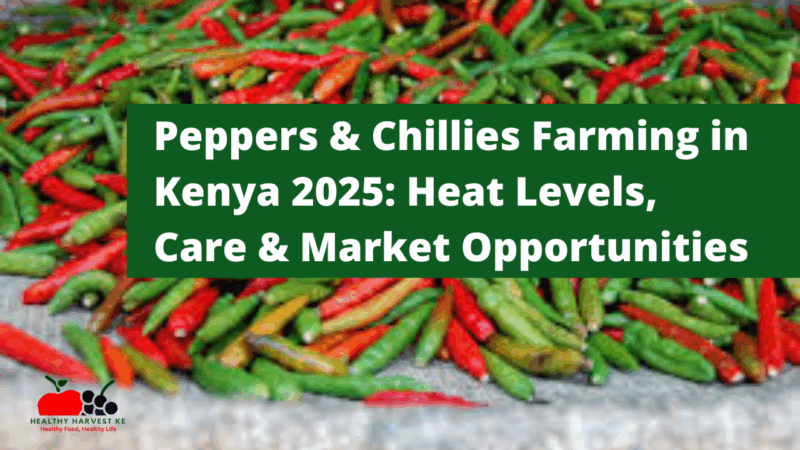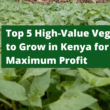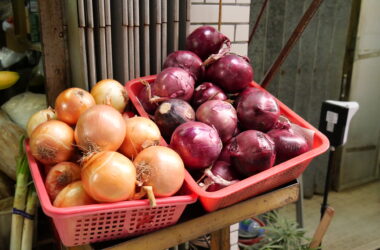In the vibrant agricultural landscape of Kenya, pepper farming has emerged as a game-changer for ambitious farmers looking to diversify beyond traditional crops. Whether you’re eyeing the sweet bell peppers (pilipili hoho) or the fiery chilies (pilipili kali) that pack a punch, this crop offers impressive returns that could have you rethinking your farming strategy.
Why Pepper Farming in Kenya Is Heating Up
The numbers don’t lie – Kenya’s chili and pepper market hit $9.4 million in 2024, jumping 12% from the previous year. That’s serious growth in an agricultural sector that’s only scratching the surface of its potential.
If you’re wondering whether pepper farming is worth your time and investment, consider this: well-managed capsicum farming can net you up to Ksh1.25 million per acre. That’s not pocket change – it’s transformative income that’s attracting farmers across the country.
What makes pepper farming particularly attractive is its adaptability. Unlike traditional crops that demand specific conditions, peppers thrive across Kenya’s diverse regions. Plus, with their relatively short growing cycles, you’re looking at faster returns compared to many other crops.
Pepper Varieties That Thrive in Kenyan Soil
Sweet Success: Capsicum Varieties
If you’re leaning toward sweet bell peppers (capsicum), you’ve got options that perform exceptionally well in Kenya’s climate:
- California Wonder: The global superstar that starts green and matures to a vibrant red
- Admiral F1: Known for consistent yields and disease resistance
- Buffalo F1: Popular for its thick walls and excellent shelf life
- Maxibel: Produces uniform, high-quality fruits
- Green Bell F1: Reliable performer in various Kenyan regions
- Yolo Wonder: Appreciated for its sweet flavor profile
These varieties offer different characteristics in terms of yield potential, disease resistance, and color at maturity – giving you flexibility to match market demands.
Bringing the Heat: Chili Pepper Varieties
For those looking to spice things up with chili farming:
- Bird’s Eye Chili: Compact plants with small, intensely hot fruits
- African Bird’s Eye Chili: A local favorite with excellent market demand
- Habanero Chilies: Known for their distinctive fruity heat
These varieties don’t just differ in heat levels – they also have unique market opportunities. Some farmers report that chili farming generates three times more income than cattle rearing on the same land area – particularly significant for farmers in arid regions looking for climate-resilient income sources.
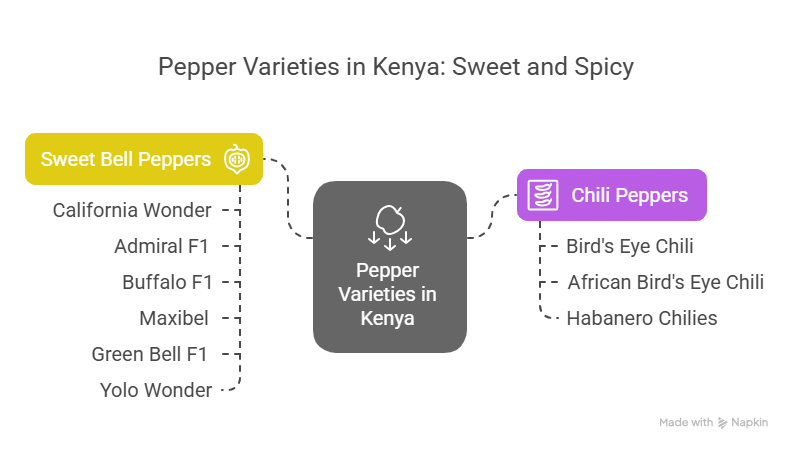
Where to Grow: Finding Your Pepper Farming Sweet Spot
Peppers aren’t particularly fussy about where they grow in Kenya, but some regions have proven especially suitable:
- Eastern Region: Consistent performers here
- Coastal Region: Excellent for both capsicum and chilies
- Rift Valley: Good climate match for various pepper varieties
- Central Kenya: Counties like Kiambu, Nakuru, Meru, and Nyeri have shown strong results
What’s particularly interesting is how well chilies perform in arid regions like Kajiado County, where traditional livestock farming faces challenges from changing climate conditions. This adaptability makes pepper farming an excellent diversification strategy for farmers in drought-prone areas.
Getting Started: The Pepper Farming Blueprint
Soil Preparation: Building the Foundation
Peppers thrive in well-drained soils with good organic matter content. Before planting:
- Till the soil thoroughly to break up compacted areas
- Mix in well-decomposed manure or compost to boost fertility
- Ensure proper drainage – peppers hate waterlogged conditions
- Test soil pH – peppers prefer slightly acidic to neutral soils (pH 6.0-7.0)
Proper soil preparation significantly impacts yield potential, so don’t cut corners here.
Spacing: Room to Thrive
How you space your pepper plants directly affects your yield. Research from Western Kenya shows that spacing configuration matters significantly:
| Spacing Configuration | Yield Per Plant | Best For |
|---|---|---|
| 40×40 cm | 555.1g | Maximum yield per plant |
| 50×40 cm | Higher branch count | Larger individual fruits |
| 30×40 cm | More plants per area | Maximizing land use |
Studies have demonstrated that the 40×40 cm spacing produced the highest yield per plant during both short and long rainy seasons. This spacing seems to hit the sweet spot between giving plants enough room to develop fully while maximizing the number of plants per area.
Water Management: The Drip Factor
Given Kenya’s increasing climate unpredictability, irrigation isn’t just nice to have – it’s essential for consistent production. Drip irrigation systems have proven especially effective for pepper cultivation for several reasons:
- They deliver water directly to the root zone, minimizing waste
- They reduce weed growth between plants
- They can be used to deliver nutrients through fertigation
Government programs now offer subsidies for drip irrigation kits, recognizing their importance in climate-smart farming. For chili production specifically, well-managed irrigation can extend the harvesting period to over six months – significantly boosting your potential income.
Pest and Disease Management: Protecting Your Investment
Pests and diseases can quickly derail even the best-planned pepper farm. Common culprits include:
- Pests: Aphids, thrips, whiteflies, and various caterpillars
- Diseases: Bacterial wilt, powdery mildew, and viral infections
Rather than relying solely on chemical pesticides, integrated pest management (IPM) approaches are increasingly recommended. These combine:
- Regular crop rotation
- Maintaining field hygiene
- Using resistant varieties when available
- Biological controls when appropriate
- Targeted chemical interventions only when necessary
This approach not only reduces your input costs but also helps protect beneficial insects and keeps your produce free from excessive chemical residues – an important factor for accessing premium markets.
The Money Talk: Investment and Returns
Startup Costs: What to Budget For
Starting your pepper farm requires investment in several key areas:
- Land preparation
- Seeds and planting materials
- Fertilizers and pesticides
- Labor costs
- Irrigation systems
Conventional field production is more accessible to small-scale farmers due to lower initial investment, while greenhouse production, though more capital-intensive, can yield higher returns through extended growing seasons and better pest control.
For a one-acre capsicum farm, initial investment typically ranges from Ksh 150,000 to Ksh 250,000 depending on your approach – but the returns justify the investment.
Yield and Revenue: The Payoff
Here’s where pepper farming gets exciting:
- Capsicum yields: 5 to 8 tons per acre with proper management
- Chili production: Up to two tonnes per week per acre during peak harvesting
With capsicum prices ranging between Ksh30 and Ksh80 per kilogram in domestic markets and well-managed chili production generating around 80,000 Kenyan shillings (US$800) per season, the math becomes compelling.
The relatively short growing cycle of peppers compared to other crops also allows for multiple harvests per year, further increasing your annual revenue potential.
Market Opportunities: Where to Sell Your Peppers
Domestic Markets: Reliable Demand
The domestic market for peppers in Kenya continues to grow, driven by:
- Increasing urbanization
- Rising consumer preference for fresh produce
- Growing middle class with more diverse food preferences
Both capsicum and chili peppers are staple ingredients in Kenyan cuisine, used in various dishes from everyday meals to restaurant offerings. This consistent local demand provides a reliable market foundation.
Export Markets: Going Global
If you’re thinking bigger, export markets represent significant opportunities:
- European Union
- United States
- Netherlands
- Germany
- Russia
- United Kingdom
- Canada
- France
- UAE
- Poland
Kenya currently exploits only about half of its potential in these export markets, indicating substantial room for growth. However, accessing these markets requires meeting international quality standards and certification requirements – something to factor into your planning.
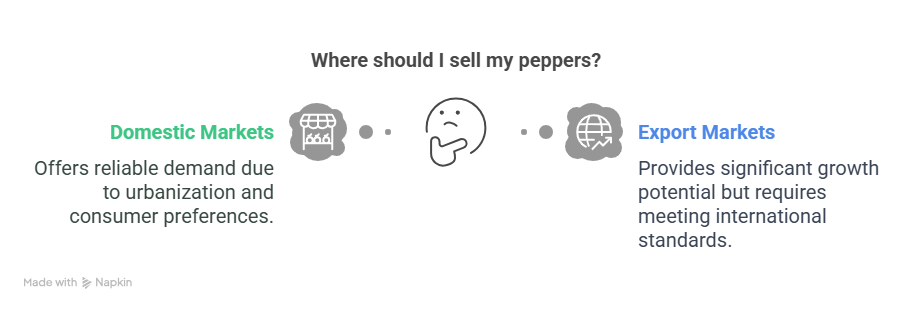
Value Addition: Multiplying Your Profits
Why sell raw peppers when you can multiply your profits through value addition? Options include:
- Processing chili into dried flakes, powder, or paste
- Production of hot sauces and other condiments
- Extraction of capsaicin for pharmaceutical applications
New technologies are making value addition more accessible. For example, new milling technology for dried chili peppers that is four times faster than traditional hand flaking has been introduced in Kenya, enabling more efficient processing.
Value addition not only increases the value of your product but also extends shelf life, reducing post-harvest losses – a win-win for your bottom line.
Climate-Smart Farming: Future-Proofing Your Pepper Farm
Climate change presents significant challenges to pepper farming in Kenya, including irregular rainfall patterns, rising temperatures, and soil degradation. To address these challenges, consider implementing these climate-smart practices:
- Drip irrigation systems that maximize water use efficiency
- Mulching to conserve soil moisture and suppress weeds
- Use of drought-resistant varieties
- Integrated pest management to reduce chemical inputs
- Greenhouse cultivation where economically viable
The Kenyan government has introduced policies and programs to support these climate-smart practices, recognizing their importance for the future sustainability of pepper farming.
Getting Started: Your Next Steps
Ready to spice up your farming portfolio with peppers? Here’s how to get started:
- Research your local market: Understand which varieties are in demand in your area
- Start small: Begin with a manageable plot to learn the ropes before scaling
- Connect with existing farmers: Learn from those who’ve already navigated the challenges
- Investigate government support: Look into subsidies for climate-smart practices
- Consider value addition from the start: Plan how you might process your harvest
The Spicy Future of Kenyan Agriculture
Pepper farming in Kenya presents a compelling opportunity for farmers looking to diversify their crops and increase their income. With strong domestic demand, growing export opportunities, and enormous potential for value addition, both capsicum and chili peppers offer promising returns on investment.
The adaptability of peppers to Kenya’s diverse climate conditions – particularly the resilience of chilies in arid regions – makes them an excellent choice for farmers concerned about climate change impacts. By adopting climate-smart practices and exploring value addition opportunities, you can build a sustainable and profitable pepper farming enterprise.
As Kenya continues to establish itself in international agricultural markets, pepper farming is poised to become an increasingly important component of the country’s agricultural sector. With the right approach, you can be part of this spicy success story.
Ready to turn up the heat on your farming income? Pepper farming might just be your next big move.




